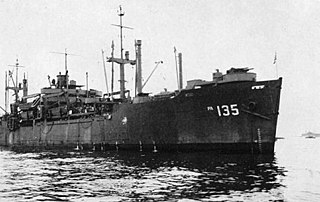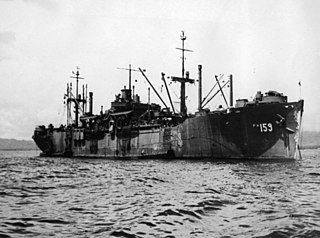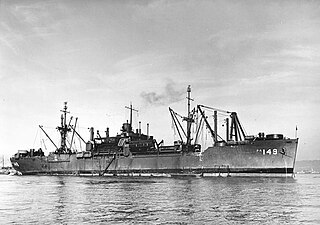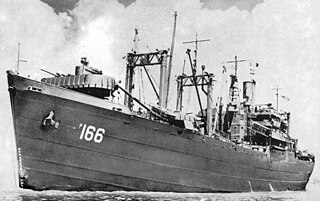
The sixth USS Relief (AH-1), the first ship of the United States Navy designed and built from the keel up as a hospital ship, was laid down 14 June 1917 by the Philadelphia Navy Yard; launched 23 December 1919; and commissioned 28 December 1920 at Philadelphia, Commander Richmond C. Holcomb, Medical Corps, USN, in command.

USS Hope (AH-7) was a Comfort-class hospital ship launched under Maritime Commission contract by Consolidated Steel Corporation, Wilmington, California, 30 August 1943; sponsored by Miss Martha L. Floyd; acquired by the Navy the same day for conversion to a hospital ship by U.S. Naval Dry Dock, Terminal Island, Calif.; and commissioned 15 August 1944.

USS Lanier (APA-125) was a Haskell-class attack transport in service with the United States Navy from 1944 to 1946. She was scrapped in 1973.

USS Aquarius (AKA-16) was an Andromeda-class attack cargo ship in the service of the United States Navy. She was named after the constellation Aquarius. She was one of a handful of World War II AKAs manned by officers and crew from the United States Coast Guard. She served as a commissioned ship for 2 years and 9 months.

USS Haskell (APA-117) was the lead ship of her class of attack transports, built for the United States Navy during World War II. She was of the VC2-S-AP5 Victory ship design type. Haskell was named for the Haskell Counties of Kansas, Oklahoma, and Texas.

USS Bosque (APA-135) was a Haskell-class attack transport in service with the United States Navy from 1944 to 1946. She was scrapped in 1973.

USS Darke (APA-159) was a Haskell-class attack transport in service with the United States Navy in from 1944 to 1946. She was scrapped in 1974.

USS Refuge (AH-11), was a hospital ship of the United States Navy during World War II. The ship was built in 1921 by the New York Shipbuilding Corp., of Camden, New Jersey, as SS Blue Hen State, but was renamed President Garfield in 1923 and then SS President Madison in 1940 for service with American President Lines. Acquired by the Navy from the War Shipping Administration on 11 April 1942 the ship was commissioned as the transport USS Kenmore until conversion to a hospital ship.

USS Samaritan (AH-10) was a hospital ship that served with the US Navy in World War II. Prior to that, she served as a US Navy transport ship under the name USS Chaumont (AP-5).

USS Pinkney (APH-2) was a Tryon-class evacuation transport that was assigned to the U.S. Navy during World War II. Pinkney served in the Pacific Ocean theatre of operations and returned home safely post-war with six battle stars but missing 18 crew members who were killed in action.

USS Bolivar (APA-34) was a Bayfield-class attack transport in service with the United States Navy from 1943 to 1946. She was then sold into commercial service and was scrapped in 1973.
USS Zaurak (AK-117) was a Crater-class cargo ship commissioned by the U.S. Navy for service in World War II. She was responsible for delivering troops, goods and equipment to locations in the war zone.

USS Bowie (APA-137) was a Haskell-class attack transport ship in service with the United States Navy from 1944 to 1946. She was scrapped in 1973.

USS Audubon (APA-149) was a Haskell-class attack transport in service with the United States Navy from 1944 to 1946. She was scrapped in 1973.

USS Latimer (APA-152) was a Haskell-class attack transport in service with the United States Navy from 1944 to 1947 and from 1950 to 1956. She was scrapped in 1972.

USS General O. H. Ernst (AP-133) was a General G. O. Squier-class transport ship for the U.S. Navy in World War II. She was named in honor of U.S. Army general Oswald Herbert Ernst. She was decommissioned in 1946 and transferred to the Army Transport Service as USAT General O. H. Ernst. She was sold privately in 1964 and renamed SS Calmar, and was scrapped in 1980.

USS Tazewell (APA/LPA-209) was a Haskell-class attack transport in service with the United States Navy from 1944 to 1946. She was scrapped in 1973.

The second USS Comfort (AH-6) was launched 18 March 1943 by Consolidated Steel Corporation, Wilmington, Los Angeles, under a Maritime Commission contract; sponsored by First Lieutenant E. Hatchitt, USAMC; transferred to the Navy the same day; converted to a hospital ship by Bethlehem Steel Co., San Pedro, Calif.; and commissioned 5 May 1944.
USS Winged Arrow (AP-170) was a La Salle-class transport of the United States Navy. The La Salle class transport had a displacement of almost 14,000 long tons (14,000 t) and were designed to ferry troops and supplies to and from the war zone during World War II.

The third USS Comet (AP-166) was a United States Navy La Salle-class transport in commission from 1944 to 1946. She saw service in the Pacific Theater of Operations during the latter stages of World War II and the immediate postwar period.


















